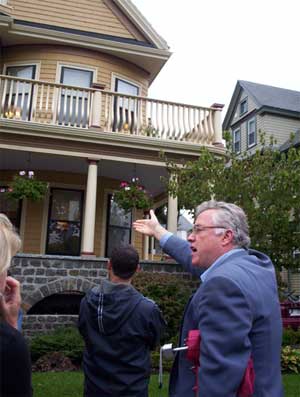
|
Ed
Gordon, president of the New England Chapter of the Victorian Society,
led a tour of Somerville's historic buildings Sept. 27.~Photo by
Chelsea Whyte |
|
By Chelsea Whyte
Despite
a wet Sunday afternoon, roughly 25 people assembled at Nathan Tufts
Park for a walking tour of area homes led by an expert on Victorian
architecture.
The Sept. 27 tour, sponsored by the Somerville
Historic Preservation Commission, was led by Ed Gordon, president of
the New England chapter of the Victorian Society of America.
The
two-hour program, titled "From Powder House Pickles to Ball Square
Brickyards," covered Nathan Tufts Park and historic houses on Broadway,
Powder House Terrace, Kidder Avenue, and Ball Square.
Gordon
began the tour at the park's Field House. Built in 1935, it was
commissioned to give work to unemployed construction workers. Their
design referenced the much older Powder House, sitting on the hill
directly above.
The Powder House was originally a windmill,
later purchased by the colonial Massachusetts government to store
gunpowder because its location was ideal for defending against an
attack. British troops seized the munitions in 1774 – a dress rehearsal
for the march to Lexington and Concord just seven months later.
After
leaving the Field House, tour goers braved the rain and the traffic to
cross the rotary at Powder House Square. Looking down Bromfield and up
Broadway, Ed Gordon tells them, "Somerville has what is probably the
finest collection of two-family houses."
Some of the grandest
of these are located on Broadway, which was known as the Road to Mystic
in the mid-1600s and served as a route out of town. With the expansion
of the electric trolley at the turn of the 20th century, Somerville's
population doubled and its landscape changed drastically as home were
built to keep up.
The next stop was 771 Broadway, which sits
on the original Tufts family homestead. Built in 1899, the home is one
of many built to meet the housing demand. Bill MacDonald, the owner and
renovator of the property, greeted the tour goers. MacDonald and his
wife purchased the house in 2003 and completely renovated it, currently
using the home as a clinic for patients suffering from eating
disorders.
Inside, MacDonald's handiwork is visible at every
turn. The exterior, including the front porch running the length of the
house, was updated with granite and composite flooring that will help
the renovation outlast the weather.
The efforts have not gone
unnoticed. The home received a preservation award from the Somerville
Historic Preservation Commission, which uses historic homes as learning
tools for students. Among its current projects is a showcase of
Somerville High School students' artwork featuring 11 historic homes at
the Center for Arts at the Armory, itself among the city's most
prominent historic structures.
|
Reader Comments